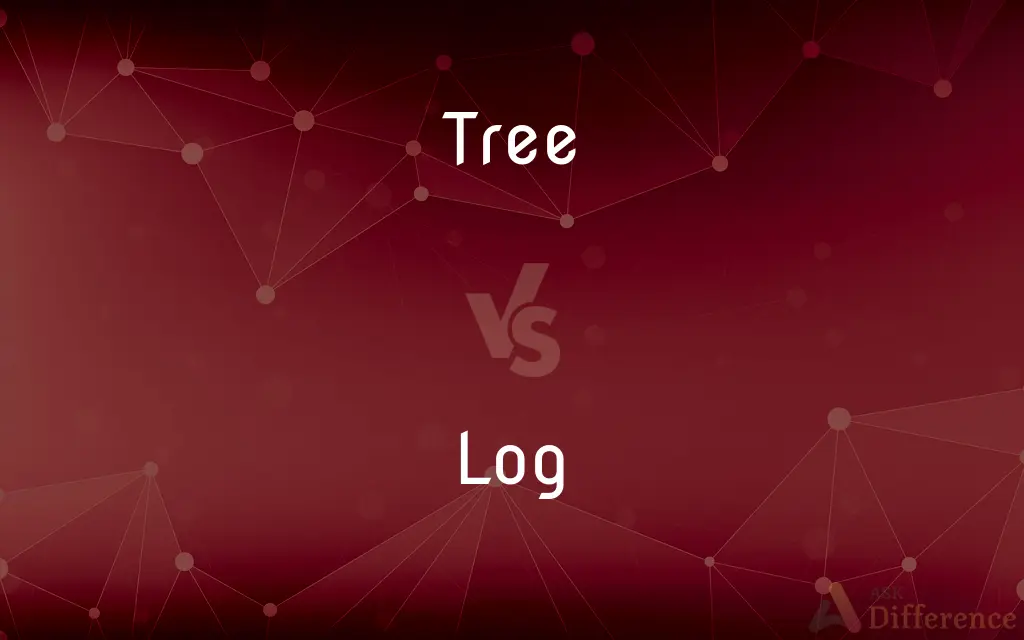Tree vs. Log — What's the Difference?
By Fiza Rafique & Maham Liaqat — Updated on April 8, 2024
A tree is a living plant with a woody trunk, branches, and leaves, while a log is a cut section of a tree trunk or large branch, often used for timber or fuel.

Difference Between Tree and Log
Table of Contents
ADVERTISEMENT
Key Differences
A tree is a perennial plant with an elongated stem, or trunk, supporting branches and leaves in most species. It is a living organism that plays a crucial role in the ecosystem. On the other hand, a log is a piece of a tree that has been cut down and is no longer living, often processed for use in construction, furniture, or as firewood.
Trees grow from seedlings to mature plants, undergoing photosynthesis to produce oxygen, offer shade, and serve as habitat for wildlife. Logs, however, are utilized after a tree has been felled and serve various human needs including building materials, paper production, and as a renewable energy source.
While trees can live for many years, even centuries, and contribute to carbon sequestration, logs represent a stage in the lifecycle of wood where it can be transformed into goods or used as fuel. The transition from tree to log marks the end of the natural life of the tree and the beginning of its utility phase in human activities.
The health and maintenance of trees are subjects of arboriculture, focusing on the care of individual trees. The processing and utilization of logs, however, fall under the forestry and lumber industries, which deal with the harvesting and transformation of wood.
Trees are celebrated for their beauty and environmental benefits, often protected and planted for conservation purposes. Logs, by their nature, are valued for their practical applications, forming the backbone of the wood product industry.
ADVERTISEMENT
Comparison Chart
Definition
A living perennial plant with a woody trunk.
A cut section of a tree trunk or large branch.
State
Living and growing.
No longer living, processed for use.
Role in Nature
Produces oxygen, provides habitat.
Used for construction, fuel, or manufacturing.
Lifecycle
Can live for years to centuries.
Represents a stage post-harvest.
Industries
Arboriculture, conservation.
Forestry, lumber, paper manufacturing.
Compare with Definitions
Tree
Provides oxygen and homes for wildlife.
The tree outside her window was a habitat for birds and squirrels.
Log
A cut piece of a tree trunk or large branch.
They used logs to build the cabin in the woods.
Tree
Planted for beauty or to improve air quality.
They planted trees along the street to enhance the neighborhood's beauty and air quality.
Log
Often used as firewood for heating or cooking.
They gathered logs for the fireplace to keep the house warm during winter.
Tree
Can live for many years, even centuries.
Some trees in the forest are known to be over two hundred years old.
Log
Can be used in furniture making or wood carving.
The artisan selected a fine log for his next piece of hand-crafted furniture.
Tree
Subject to arboriculture and conservation efforts.
The city's arboriculture program focuses on planting and caring for urban trees.
Log
Part of the wood product industry supply chain.
Logs are a critical supply for industries ranging from paper manufacturing to home building.
Tree
A large plant with a trunk, branches, and leaves.
The oak tree in the backyard has grown to a magnificent size over the years.
Log
Processed for timber, paper, or fuel.
The logs were transported to the mill to be turned into lumber for construction.
Tree
In botany, a tree is a perennial plant with an elongated stem, or trunk, supporting branches and leaves in most species. In some usages, the definition of a tree may be narrower, including only wood plants with secondary growth, plants that are usable as lumber or plants above a specified height.
Log
A part of the trunk or a large branch of a tree that has fallen or been cut off
A roaring log fire
She tripped over a fallen log
Tree
A woody perennial plant, typically having a single stem or trunk growing to a considerable height and bearing lateral branches at some distance from the ground.
Log
An official record of events during the voyage of a ship or aircraft
A ship's log
Tree
A wooden structure or part of a structure.
Log
An apparatus for determining the speed of a ship, originally one consisting of a float attached to a knotted line that is wound on a reel, the distance run out in a certain time being used as an estimate of the vessel's speed.
Tree
A thing that has a branching structure resembling that of a tree.
Log
The Ranfurly Shield, an interprovincial rugby union trophy competed for annually in New Zealand
Errors late in the game cost them a shot at the log of wood
Tree
Force (a hunted animal) to take refuge in a tree.
Log
Short for logarithm
Log x
Log values
Tree
(of an area) planted with trees
Sparsely treed grasslands
Log
Enter (an incident or fact) in the log of a ship or aircraft or in another systematic record
The incident has to be logged
Tree
A perennial woody plant having a main trunk and usually a distinct crown.
Log
Cut down (an area of forest) in order to exploit the timber commercially
There are plans to log 250,000 hectares of virgin rainforest
Tree
An herbaceous plant or shrub resembling a tree in form or size.
Log
A usually large section of a trunk or limb of a fallen or felled tree.
Tree
Something that resembles a tree in form, especially a diagram or arrangement that has branches showing relationships of hierarchy or lineage.
Log
A long thick section of trimmed, unhewn timber.
Tree
(Computers) A structure for organizing or classifying data in which every item can be traced to a single origin through a unique path.
Log
A device trailed from a ship to determine its speed through the water.
Tree
A wooden beam, post, stake, or bar used as part of a framework or structure.
Log
A record of a ship's speed, its progress, and any shipboard events of navigational importance.
Tree
A saddletree.
Log
The book in which this record is kept.
Tree
A gallows.
Log
A record of a vehicle's performance, as the flight record of an aircraft.
Tree
The cross on which Jesus was crucified.
Log
A record, as of the performance of a machine or the progress of an undertaking
A computer log.
A trip log.
Tree
To force up a tree
Dogs treed the raccoon.
Log
A logarithm.
Tree
(Informal) To force into a difficult position; corner
The reporters finally treed the mayor.
Log
To cut down, trim, and haul the timber of (a piece of land).
Tree
To supply or cover with trees
A hillside that is treed with oaks.
Log
To cut (timber) into unhewn sections.
Tree
A perennial woody plant, not exactly defined, but differentiated from a shrub by its larger size (typically over a few meters in height) or growth habit, usually having a single (or few) main axis or trunk unbranched for some distance above the ground and a head of branches and foliage.
Hyperion is the tallest living tree in the world.
Birds have a nest in a tree in the garden.
Log
To enter in a record, as of a ship or an aircraft.
Tree
Any plant that is reminiscent of the above but not classified as a tree (in any botanical sense).
The banana tree
Log
To travel (a specified distance, time, or speed)
Logged 30,000 air miles in April.
Tree
An object made from a tree trunk and having multiple hooks or storage platforms.
He had the choice of buying a scratching post or a cat tree.
Log
To spend or accumulate (time)
Had logged 25 years with the company.
Tree
A device used to hold or stretch a shoe open.
Log
To cut down, trim, and haul timber.
Tree
The structural frame of a saddle.
Log
The trunk of a dead tree, cleared of branches.
They walked across the stream on a fallen log.
Tree
(graph theory) A connected graph with no cycles or, if the graph is finite, equivalently a connected graph with n vertices and n−1 edges.
Log
Any bulky piece as cut from the above, used as timber, fuel etc.
Tree
(computing theory) A recursive data structure in which each node has zero or more nodes as children.
Log
Anything shaped like a log; a cylinder.
Tree
(graphical user interface) A display or listing of entries or elements such that there are primary and secondary entries shown, usually linked by drawn lines or by indenting to the right.
We’ll show it as a tree list.
Log
(nautical) A floating device, usually of wood, used in navigation to estimate the speed of a vessel through water.
Tree
Any structure or construct having branches representing divergence or possible choices.
Family tree; skill tree
Log
(figuratively) A blockhead; a very stupid person.
Tree
The structure or wooden frame used in the construction of a saddle used in horse riding.
Log
A heavy longboard.
Tree
Marijuana.
Log
(figuratively) A rolled cake with filling.
Tree
(obsolete) A cross or gallows.
Tyburn tree
Log
(mining) A weight or block near the free end of a hoisting rope to prevent it from being drawn through the sheave.
Tree
(chemistry) A mass of crystals, aggregated in arborescent forms, obtained by precipitation of a metal from solution.
Log
(vulgar) A piece of feces.
Tree
(cartomancy) The fifth Lenormand card.
Log
(vulgar) A penis.
Tree
(transitive) To chase (an animal or person) up a tree.
The dog treed the cat.
Log
A logbook, or journal of a vessel's (or aircraft's) progress.
Tree
(transitive) To place in a tree.
Black bears can tree their cubs for protection, but grizzly bears cannot.
Log
A chronological record of actions, performances, computer/network usage, etc.
Tree
(transitive) To place upon a tree; to fit with a tree; to stretch upon a tree.
To tree a boot
Log
(computer science) Specifically, an append-only sequence of records written to file.
Tree
(intransitive) To take refuge in a tree.
Log
A Hebrew unit of liquid volume (about 3{{nbsp}}liter).
Tree
Any perennial woody plant of considerable size (usually over twenty feet high) and growing with a single trunk.
Log
Synonym of logarithm. Category:en:Functions
To multiply two numbers, add their logs.
Tree
Something constructed in the form of, or considered as resembling, a tree, consisting of a stem, or stock, and branches; as, a genealogical tree.
Log
(sciences) A difference of one in the logarithm, usually in base 10; an order of magnitude.
Tree
A piece of timber, or something commonly made of timber; - used in composition, as in axletree, boottree, chesstree, crosstree, whiffletree, and the like.
Log
(transitive) To cut trees into logs.
Tree
A cross or gallows; as Tyburn tree.
[Jesus] whom they slew and hanged on a tree.
Log
(transitive) To cut down (trees).
Tree
Wood; timber.
In a great house ben not only vessels of gold and of silver but also of tree and of earth.
Log
(intransitive) To cut down trees in an area, harvesting and transporting the logs as wood.
Tree
A mass of crystals, aggregated in arborescent forms, obtained by precipitation of a metal from solution. See Lead tree, under Lead.
Log
(transitive) To make, to add an entry (or more) in a log or logbook.
To log the miles travelled by a ship
Tree
To drive to a tree; to cause to ascend a tree; as, a dog trees a squirrel.
Log
(transitive) To travel (a distance) as shown in a logbook.
Tree
A tall perennial woody plant having a main trunk and branches forming a distinct elevated crown; includes both gymnosperms and angiosperms
Log
(transitive) To travel at a specified speed, as ascertained by a chip log.
Tree
A figure that branches from a single root;
Genealogical tree
Log
A Hebrew measure of liquids, containing 2.37 gills.
Tree
English actor and theatrical producer noted for his lavish productions of Shakespeare (1853-1917)
Log
A bulky piece of wood which has not been shaped by hewing or sawing.
Tree
Chase a bear up a tree with dogs and kill it
Log
An apparatus for measuring the rate of a ship's motion through the water.
Log
The record of the rate of speed of a ship or airplane, and of the course of its progress for the duration of a voyage; also, the full nautical record of a ship's cruise or voyage; a log slate; a log book.
Log
A record and tabulated statement of the person(s) operating, operations performed, resources consumed, and the work done by any machine, device, or system.
Log
A weight or block near the free end of a hoisting rope to prevent it from being drawn through the sheave.
Log
A record of activities performed within a program, or changes in a database or file on a computer, and typically kept as a file in the computer.
Log
To enter in a ship's log book; as, to log the miles run.
Log
To record any event in a logbook, especially an event relating to the operation of a machine or device.
Log
To engage in the business of cutting or transporting logs for timber; to get out logs.
Log
To move to and fro; to rock.
Log
A segment of the trunk of a tree when stripped of branches
Log
Large log at the back of a hearth fire
Log
The exponent required to produce a given number
Log
A written record of messages sent or received;
They kept a log of all transmission by the radio station
An email log
Log
A written record of events on a voyage (of a ship or plane)
Log
Measuring instrument that consists of a float that trails from a ship by a knotted line in order to measure the ship's speed through the water
Log
Enter into a log, as on ships and planes
Log
Cut lumber, as in woods and forests
Common Curiosities
Can logs be used for anything other than fuel?
Yes, logs can be processed into lumber for construction, furniture, paper, and various other wood products.
What is a tree?
A tree is a large living plant with a woody trunk, supporting branches and leaves or needles in most species.
How long can a tree live?
Depending on the species, trees can live from several decades to several thousand years.
Why are trees important?
Trees are vital for producing oxygen, providing habitats for wildlife, and contributing to the environment's health.
Can trees and logs coexist in urban areas?
Yes, urban areas often have trees for environmental and aesthetic purposes, and logs may be used in urban construction and furniture.
What happens to trees when they are cut down?
When trees are cut down, they can be processed into logs and then used for various purposes, such as building materials or firewood.
What is a log?
A log is a large piece of a tree trunk or a substantial branch that has been cut from the tree.
How does a tree differ from a log?
A tree is a living organism, part of the ecosystem, while a log is a piece of wood that has been cut from a tree for use.
What industries are involved with trees and logs?
The arboriculture and conservation industries focus on trees, while forestry and lumber industries deal with logs.
How are logs processed?
Logs are often processed in sawmills, where they are cut into lumber or other wood products, or used as raw material for paper production.
Share Your Discovery

Previous Comparison
Bribe vs. Incentive
Next Comparison
Museum vs. AquariumAuthor Spotlight
Written by
Fiza RafiqueFiza Rafique is a skilled content writer at AskDifference.com, where she meticulously refines and enhances written pieces. Drawing from her vast editorial expertise, Fiza ensures clarity, accuracy, and precision in every article. Passionate about language, she continually seeks to elevate the quality of content for readers worldwide.
Co-written by
Maham Liaqat













































